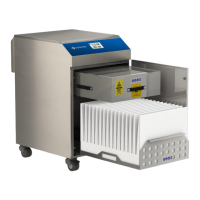EPT076596 Issue 1 – March 2022
32
Maintenance
Maintenance General
Periodic general maintenance must frequently be carried
out on the extraction system, when carrying out
maintenance ensure isolation from all energy sources.
Periodic general maintenance includes as a minimum to
dust down all exterior air vents to not limit cooling and
extraction. Functionality tests should also be carried out to
ensure all controls and systems are operating as they should
be.
User maintenance is limited to cleaning the unit and filter
replacement, only trained maintenance technicians are
authorised to carry out component testing and
replacement. Unauthorised work or the use of unauthorised
replacement filters may result in a potentially dangerous
situation and/or damage to the extractor unit and will
invalidate the manufacturer’s warranty.
Cleaning the unit
The stainless steel units should be cleaned with a
proprietary stainless steel cleaner, in accordance with the
manufacturer’s user instructions.
Replacing Filters
The DPX3500 system constantly monitors the condition of
the individual particle filters. As the filters block the
DPX3500 display will show the relevant filter symbol filling
up. (see section 5-05 for screen details). If a filter warning
appears the filter is recommended to be replaced latest
during the next planned maintenance in order to prevent
additional downtime.
A log of the changes should be maintained by the user.
The filters require attention when the display shows the
filter output signal is high, this signals 85% blockage across
the two filters.
It is recommended that a spare set of filters are kept on site
to avoid prolonged unit unavailability (note, main filters
should only be used for 2 years after manufacture date
listed on the filter for maximum efficiency). Part numbers
for replacement filters can be found on the filters fitted in
your system.
To prevent overheating, units should not be run with a
blocked filter condition, or with dust obstruction of Inlets /
Outlets.
Pressure sensor maintenance
It is recommended when changing the pre-filter (refer to
section 6.02 for pre-filter location and removal) the pressure
sensing tube should be cleaned to maintain system
accuracy. This section details how to clean the pressure
sensing tube, however customer risk assessments should be
followed regarding PPE and access to the sensor.
To clean the pressure sensing tube:
1. Disconnect the silicone hose from the top of the
sensor tube.
2. Use a pipe cleaner to clear all debris from the
stainless-steel tube. (Compressed air may also be
used to clean the stainless-steel tube, ensure that
the silicone hose has been disconnected as this will
damage the pressure sensor).
3. Connect the silicone hose back to the top of the
stainless steel sensor tube.

